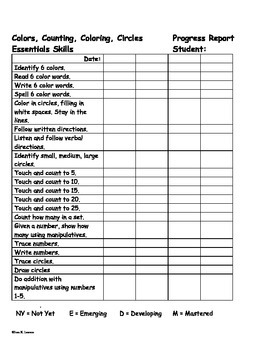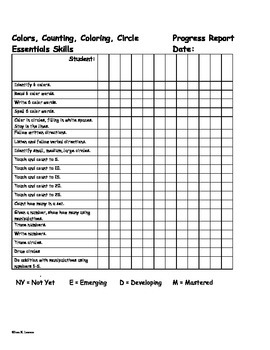Fine Motor, Colors, Counting, Coloring, Shapes--Track Progress Checklist
- PDF
Description
Track progress for 101 essential skills needed for students to be successful in school: fine motor, color ID, coloring, counting, circles, reading, writing; 2-D and 3-D shapes identification, matching, building, following directions, and much more.
101 Essential Skills BUNDLE: Fine Motor, Colors, Shapes for Teachers and OT
Purchase this bundle of over 200 pages of activities, printables, visual instruction for each of these essential skills. Progress Reports and Data Collection Charts included in the bundle. This is a required kit for students with fine motor delays.
20 Essential Skills: Colors, Counting, Writing, Coloring, Following Directions
Identify 6 colors.
Read 6 color words.
Write 6 color words.
Spell 6 color words.
Color in circles, filling in white spaces. Stay in the lines.
Follow written directions.
Listen and follow verbal directions.
Identify small, medium, large circles.
Touch and count to 5.
Touch and count to 10.
Touch and count to 15.
Touch and count to 20.
Touch and count to 25.
Count how many in a set.
Given a number, show how many using manipulatives.
Trace numbers.
Write numbers.
Trace circles.
Draw circles
Do addition with manipulatives using numbers 1-5.
20 Essential Skills: Shapes, Drawing, Building, Following Directions
Expressively identify basic 2-D shapes: circle, square, triangle, rectangle, oval.
Receptively identify basic 2-D shapes: circle, square, triangle, rectangle, oval.
Write words: circle, square, triangle, rectangle, oval.
Read words: circle, square, triangle, rectangle, oval.
Expressively identify basic 3-D shapes: cube, cone, cylinder, sphere.
Receptively identify basic 3-D shapes: cube, cone, cylinder, sphere.
Write words: cube, cone, cylinder, sphere.
Read words: cube, cone, cylinder, sphere.
Differentiate between 2-D and 3-D shapes.
Follow written directions.
Listen and follow verbal directions.
Identify small, medium, large.
Name relative positions of objects.
Sort shapes.
Trace shapes.
Draw shapes.
Create pictures or designs with shapes.
Build pictures or designs with shapes, following a model.
Identify 2-D and 3-D shapes.
Identify shapes in the environment.
Ready-to-use activities that teach the specific skills in these tracking charts are available in the TpT store: Autism Resources by Jean K. Lawson:
20 Essential Skills: Colors, Counting, Writing, Coloring, Following Directions
Over 50 pages covering 20 Essential Skills students will build on as they go through school--with pages of differentiation. Progress Reports for these skills included by student and group of students.
20 Essential Skills: Shapes, Drawing, Building, Following Directions
80 pages covering 20 Essential Skills students will build on as they go through school--with pages of differentiation. Progress Reports for these skills included by student and group of students.
Many of these essential skills are learned in preschool and early kindergarten. However, some students in elementary and even secondary schools have still not mastered these essential skills. The Essential Skills Series allows students of any age to work on those early skills.
Differentiation and Graduated Levels
Resources in the Essential Skills Series have differentiated levels of an activity. Students in a group at different skill levels can be working on similar work at the same time. Students can grow into higher levels as they build their skills. A teacher or therapist can put the pages together in a booklet for the student to continue into higher levels of the same skill over time.
These two products Help Students to Build Toward These Common Core Standards
K.G.A.1: Describe objects in the environment using names of shapes, and describe the relative positions of these objects using terms such as above, below, beside, in front of, behind, and next to.
K.G.A.2: Correctly name shapes regardless of their orientations or overall size.
K.G.A.3: Identify shapes as two-dimensional (lying in a plane, “flat”) or three-dimensional (“solid”).
K.G.B.4: Analyze and compare two- and three-dimensional shapes, in different sizes and orientations, using informal language to describe their similarities, differences, parts (e.g., number of sides and vertices/“corners”) and other attributes (e.g., having sides of equal length) .
K.G.B.5: Model shapes in the world by building shapes from components (e.g., sticks and clay balls) and drawing shapes.
K.G.B.6: Compose simple shapes to form larger shapes. For example, “Can you join these two triangles with full sides touching to make a rectangle?”
K.CC.A.1: Count to 100 by ones and by tens
K.CC.A.3: Write numbers from 0 to 20. Represent a number of objects with a written numeral 0-20 (with 0 representing a count of no objects).
K.CC.B.4a: When counting objects, say the number names in the standard order, pairing each object with one and only one number name and each number name with one and only one object.
K.CC.B.4b: Understand that the last number name said tells the number of objects counted. The number of objects is the same regardless of their arrangement or the order in which they were counted.
K.CC.B.5: Count to answer “how many?” questions about as many as 20 things arranged in a line, a rectangular array, or a circle, or as many as 10 things in a scattered configuration; given a number from 1–20, count out that many objects.
Fine Motor Skills for School Success--61 Essential Skills
Helps Students to Build Toward These Common Core Standards
Text Types & Purposes: Use a combination of drawing, dictating, and writing to compose …
L.K.1.A Print many upper- and lowercase letters.
K.G.B.5: Model shapes in the world by building shapes from components (e.g., sticks and clay balls) and drawing shapes.
K.CC.A.3: Write numbers from 0 to 20. Represent a number of objects with a written numeral 0-20 (with 0 representing a count of no objects).
Related Resources:
Handwriting Tools for Teachers, Students, OT, K-3; Includes all the common core standards for handwriting. Buy by grade level or save and by the bundle of all four grades.
Task Analysis BUNDLE: 15 Routines from ALL 3 Sets, Visuals, Data Collection. Buy sets of five or a bundle of all 15.
ELA Essential Elements for Cognitive Disabilities: Data Collection, K-5
Math Essential Elements for Cognitive Disabilities: Data Collection, K-5
Essential Elements (EE) are linked to the grade-level expectations in the CCSS, building a bridge to academics. EE will be assessed with Dynamic Learning Maps. Buy by grade level or save and buy all six grades
Your feedback helps in the development of future resources to meet your needs and help students be successful. Please drop me a note at AutismResources@hotmail.com and leave feedback at my TpT store.
If you like the products in this store, make sure to FOLLOW ME by clicking the STAR at the top of my home page and you’ll receive notices of free updates to products you have downloaded and emails when products are on sale. Check out my WEBSITE AND BLOG for more information you can use in your classroom and share with parents. Visit my page on FACEBOOK for conversation with others who do what you do.
Many thanks--Jean



